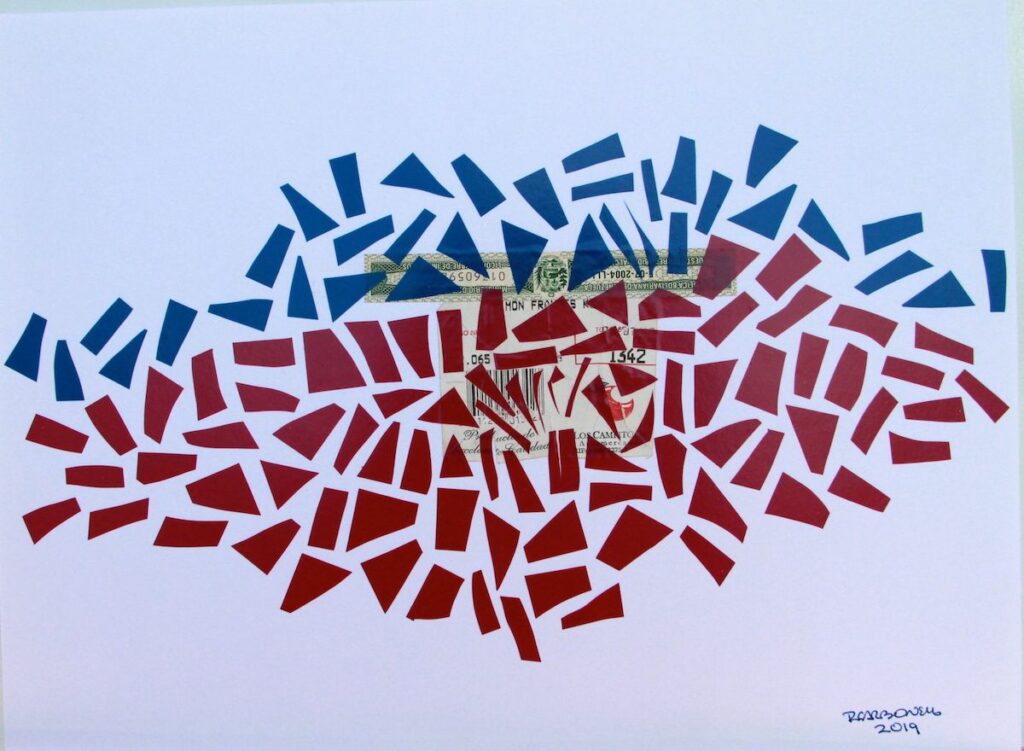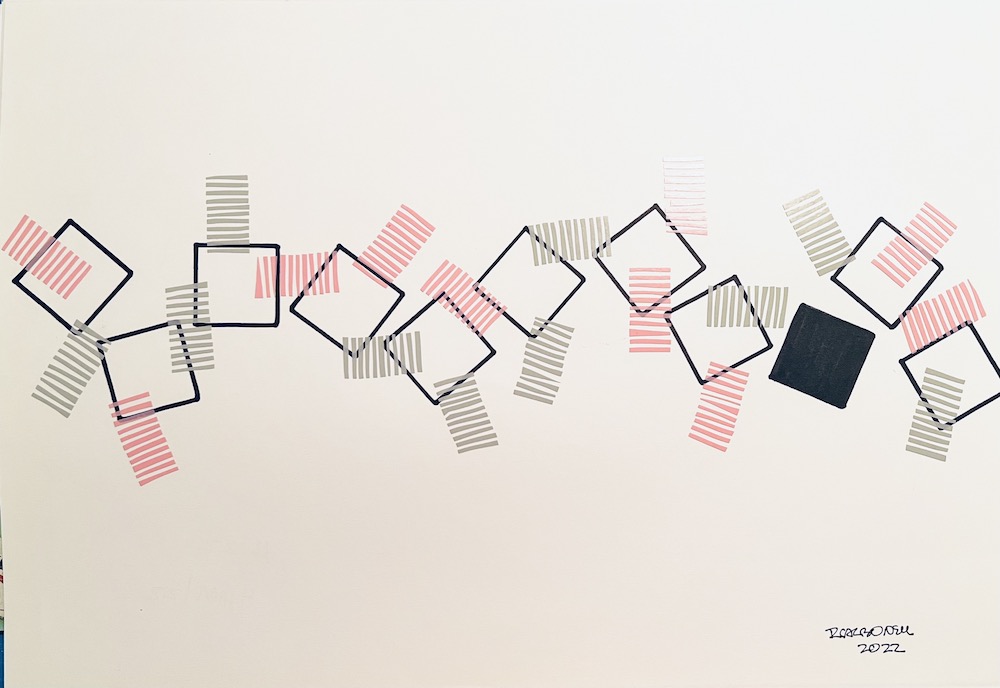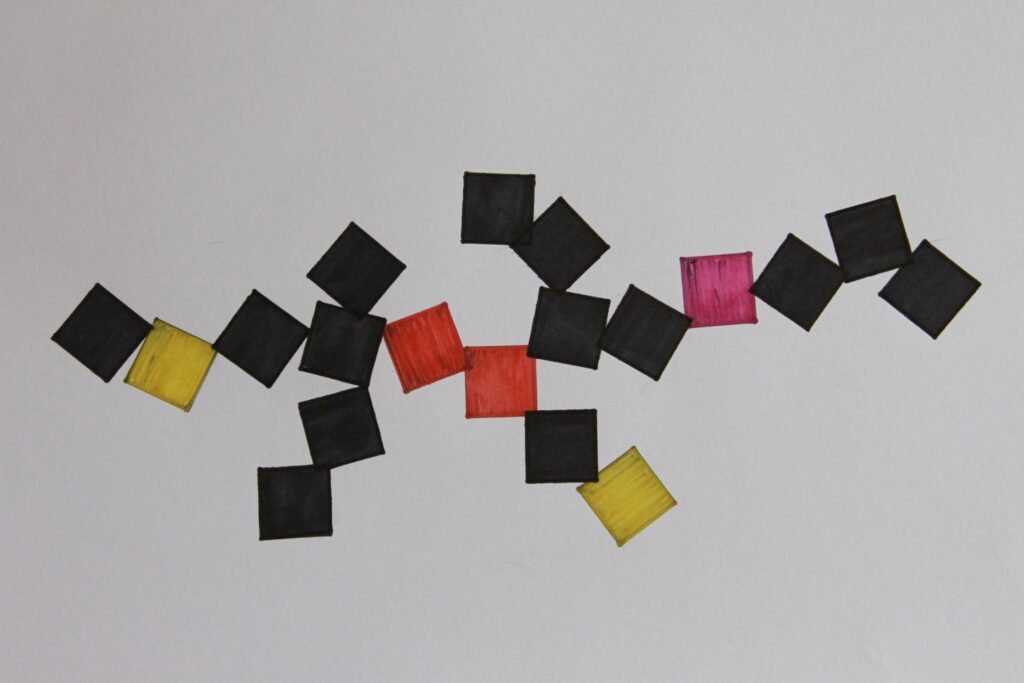INTERVIEW WITH RICARDO CARBONELL/CONTEMPORARY COLLAGE
BY MILAGROS BELLO *
Venezuelan artist Ricardo Carbonell has been developing his work for over ten years. Quietly and patiently, intimately, and privately, without fanfare or demonstrations, the artist quietly carries out his creative work at home, where each day he dedicates time to his discoveries in contemporary collage, experimenting with new methods. One of his most active fronts currently he is working on a particular technique of contemporary collage that brings together objects from everyday life: stickers, commercial labels, luggage tags, tax stamps, stamps, beer cans, wine bottles, envelopes, ice cream sticks, bottle caps, business cards, maps, packaging, credit cards, out-of-circulation banknotes to restore time and give an identity to the collective memory characterized by consumption, accumulation, capitalist production strategies, and brand creation. The objects in Carbonell’s work function as remnants of time and as relics. Carbonell also uses, in his collages, an unorthodox approach that goes further: the meticulous cutting of electrical tape into small strips, which he “glues” in geometric numerical sequences, creating expansive and changing rhythmic visual pathways. He also incorporates crayons and markers in abstract interventions traced with rectilinear geometries in columns and spiral, triangular, and cubic shapes. A notable fact is that these lines and marks always hide structural numerology, the number 11 and its multiples, as a sharp political reference that marked the world and him, which were the events of September 11, 2001, in the USA. He works indistinctly on paper or canvas, paving the way for reflection on new directions that can be explored in contemporary collage. In a creative, systematic way, his works are produced in sets and series, each time linked by a conceptual thread. The work is meticulous and focused, requiring long hours of patient and determined labor. His studio is an intimate space no larger than a room, where in addition to his work desk, there are books, paintings, markers, crayons, and objects collected for over ten years, the product of a discerning eye honed in the throwaway society. Since 2019, he has consecutively participated in curated exhibitions at Curator’s Voice Art Projects and MIA Curatorial Projects. He has also been part of fairs such as West Palm Beach, Hamptons Art Fair, and ICFF New York. His work has been featured in two biennial editions at the European Cultural Center in Venice, Italy, in the context of the Venice Biennale (2019, 2022).
MILAGROS BELLO: What led you to use contemporary collage as a technique in your artistic work?
RICARDO CARBONELL: The root of my inclination for contemporary collage dates to a constant search for images. Since childhood, I have collected objects that captured my attention in a special box. They were all sorts of found elements, a passion for collecting, for preserving. Memories of the collages I admired at MOMA during the 1960s remain vivid, those by Picasso, Duchamp, Marx Ernst, and Kurt Schwitters. I was struck by how they repositioned fragments of different images. I was discovering a new reality.
Similarly, I was impressed by the iconic works of Andy Warhol. The famous Campbell’s soup cans were essentially a reappropriation of an image borrowed from another context that Warhol transferred to a new setting, creating new meanings. I was also impressed by the skill of artists like Alejandro Otero, who used newspapers, brushes, and saws in their works, a great creative technique I saw at the Museum of Fine Arts. Otero broke with traditional methods and opened a new avenue for the unrestricted use of materials, proceeding with great creative freedom. In the 1970s, I kept copies of the newspaper “El Nacional” for years, along with product labels, which planted the idea of storing materials for future use. For years, I maintained this practice of saving material that I could use later. I’ve been collecting them with an almost obsessive insistence, like anthropological collecting. Elements such as stamps, seals, luggage tags, packaging, and everything considered waste accumulate a history, reveal a historical or social moment, and show the permanence of realities and circumstances over time. There was a need to gather objects that represented experienced moments and then give them new life in a new narrative, as the “collagists” of the 1960s or Warhol did, harmonizing elements into unique units and blocks of new meanings. Discovering the existence of collages gave me the confidence that collecting could be effective. Patience has been my constant ally in creating each piece. However, I still want to tackle the challenge of producing large collages using heavier and more complex materials.

MB: What is the significance behind incorporating labels, luggage tags, consumer products, and other elements in your artwork?
RC: Within my artworks, I find meaning in the inclusion of a variety of elements: labels from cans, cardboard boxes, tax stamps on alcoholic beverages, fragments of sweetener packets, ice cream sticks, stickers, candy wrappers, credit cards, product packaging, and coins, as well as luggage and parking tickets, invoices, business cards, stamps, pens, wine labels, and metal plates. The purpose behind this choice is to resurrect and give new life to objects that have served their original purpose, allowing them to become a crucial part of my artistic compositions. I am intensely fascinated with collecting tax stamps; their presence evokes memories of when I discovered them at fifteen. Similarly, parking tickets, legally known as “tarjas,” old banknotes, and broken fragments of sweetener packets have obsessively captured my interest. Emphasis is placed on broken shards, as they reflect life’s unpredictable and non-linear nature. Just as we, as individuals, are composed of various elements and experiences that gradually come together, we are like a puzzle in constant formation. This amalgamation of elements finds cohesion in our values and the dimensions we can encompass.

MB: How would you describe the meticulous technique of cutting straight strips of electrical tape in various sizes in your creations?
RC: The technique I employ in my creations involves skillfully cutting electrical tape into various sizes and rectilinear shapes but always aiming for the organic nature of the cut, allowing subtle irregularities that reveal the movements of the hands rather than the cold precision of a machine cutting material. Making these cuts goes beyond the surface; it involves an inner challenge that tests my skill and perseverance. Each cut demands strength and concentration, serving as a self-evaluation exercise. Each cut requires dexterity and precision. The scissors become an essential tool in this process, demanding a more intensive skill set than what might be needed for a simple brush in other forms of artistic expression. Each cut is like a stroke on the canvas. The entire construction of my work is based on the pre-selection and arrangement of these “strokes” that exist in my mind before they are physically executed. My goal is to achieve visual surprises in the accidental tracing of cuts as an expression of the nature of human movement. Currently, I’m exploring the possibility of establishing a deep connection between my series of electrical tape-cut columns and the world of musical composition, seeking to create a unique and meaningful amalgamation of both artistic expressions.

MB: What role do the colors available in the industrial tape market play in your artistic process?
RC: In my artistic process, the colors available in the industrial tape market play an essential and unique role. I have developed a numerical system that allows me to categorize different colors. Despite the inherent limitations of the color palette of these industrial tapes, I have managed to transcend these restrictions and use them as a creative starting point rather than an inhibiting obstacle. In every new country I can visit, I explore the variations and options of adhesive tapes available in the local market. This constant research enriches my expressive possibilities. Currently, I am working on a series of canvas pieces where I blend colors, meticulously placing adhesive tape to form grids or networks. Collage transforms into something else, a leap into a different visual context.

MB: How do you use numbers to determine the organization of the rectangles of adhesive tape in each artwork, and what importance do these numbers hold in your creative work?
RC: Using numbers in the arrangement of adhesive tape rectangles within each artwork has a profound and multifaceted meaning in my creative approach. In particular, I have adopted the number 11 as a symbol in honor of the victims of September 11, 2001, an event that transformed the course of our civilization and marked a turning point in our history. My choice of this number seeks to pay tribute and remember its influence. The consistent presence of the number 11 in my work establishes an organizational system or method. It drives me to maintain regularity in my series without restricting my ability to explore other alternatives. In addition to the 11 series, I have developed the 46 and 19 series, each with its own set of implications and variations. Using numbers serves a pragmatic function by avoiding distractions and ambiguities in identifying my works while infusing a sense of order and coherence throughout them, similar to how the assigned numbers to Jackson Pollock’s works impacted their visual presentation. One of my most significant works is Symphony #21, a composition on paper that spans 10.08 meters (399 inches). This piece consists of 21 parts, each formed by seven segments of 3 columns, and each column is further divided into five parts, representing different colors. Each piece within this visual symphony carries harmony and meticulous balance, resonating throughout the composition. My approach to contemporary collage is where I’m venturing into new coordinates.



**Curator Milagros Bello holds a Ph.D. in Sociology with a doctoral thesis in Sociology of Art from the University of Sorbonne (Paris VII-Jussieu) and a master’s degree in art history from the University of Sorbonne (University of Paris I), both located in Paris, France. She earned a bachelor’s degree in psychology, specializing in Clinical Psychology, from the Central University of Venezuela and pursued postgraduate courses in Family and Individual Counseling in her home country, Venezuela. Dr. Bello is an art critic, a member of the International Association of Art Critics (AICA), and a member of the National Federation of Psychologists of Venezuela. She is an independent curator and directs MIA Curatorial Projects (formerly known as Curator’s Voice Art Projects, founded in 2010 in the Wynwood Art District of Miami). From 2010 to the present, Dr. Bello has curated numerous contemporary art exhibitions at both the national and international levels. During April-November 2022, as part of the 59th Venice Biennale, she curated the exhibition “Americans: Current Imaginaries,” which was on display until November 2022 at the European Cultural Center in Venice, Italy. She is a lecturer at museums and art institutes, a writer for local and international art magazines, and a former editor-in-chief of the art magazine Arte Al Dia International. For fourteen years, from 2000 to 2014, she taught as an art professor in various theoretical areas of specialization, including Critical Theories, Art History, Modern and Contemporary Photography History, and Sociology, at the postgraduate and undergraduate levels at American universities such as Florida International University (FIU), Florida Atlantic University (FAU), Miami International University (The Art Institute/Miami), and Istituto Marangoni/Miami. She is the director and chief curator of MIA Curatorial Projects in Miami (formerly Curator’s Voice Art Projects, founded in the Wynwood Art District in 2010). Dr. Bello is also a mentor and motivational coach for artists. You can find her on Instagram at @milagrosbellocurator and @miacuratorial, and you can contact her at [email protected].




